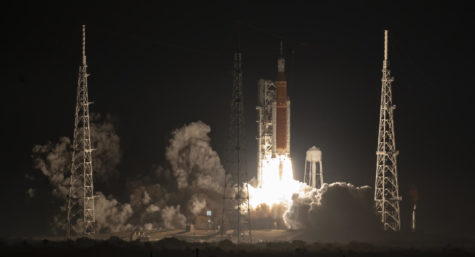NASA launches Artemis 1 to Moon 50 years after Apollo 17

NASA’s Space Launch System rocket carrying the Orion spacecraft launches on the Artemis I flight test, Wednesday, Nov. 16, 2022
December 12, 2022
Roaring off launchpad 39B at Kennedy Space Center in Florida on Nov. 16, 50 years after the golden era of the Apollo missions last carried astronauts to the Moon, the Artemis I rocket serves as a test flight for the Orion spacecraft that will return American boots to the lunar surface no later than 2025.
The third time was the charm as the previous two attempts in Aug. and Oct. had been halted due to mechanical problems, fuel leaks, and Hurricanes Ian and Nicole. The launch was a success, with the orange glow of the rocket fuel propelling the towering Artemis to the Moon and illuminating the dark, midnight Florida skies. The commanding presence of the SLS rocket for the Artemis mission resembles the look of the Saturn V for the Apollo missions.
Engineering teacher Kurt Osmer recalls watching the Apollo missions. He stated, “I was 12 years old during the last Apollo mission and I was almost nine when Neil Armstrong stepped on the Moon.”
After these missions ended, NASA turned its attention towards the Space Shuttle and the ISS. The age of Moon exploration became a fond, distant memory.
Now, 50 years after Apollo 17, NASA is seeking to return to the Moon with Artemis and revive their mission for continued and detailed space exploration. Joshua Greenbaum ’25 said, “America returning to the moon after 50 years is a step in the right direction of space exploration. I think that exploring space will further our knowledge about the universe and help us discover things we didn’t know were possible.”
This uncrewed mission lasted for 25 days, with Orion orbiting the moon, conducting all of the steps necessary for a crewed mission to land on the moon, then heading back to Earth, and landing in the Pacific Ocean on Dec. 11.
When reentering the Earth’s atmosphere, the critical heat shield will be tested with temperatures that are similar to the Sun’s surface. The success of the internal systems of Orion will determine how realistic the 2025 moon landing goal will be.
NASA’s goal is to land the first woman and person of color on the moon in 2025, and later build a lunar base and the Gateway space station orbiting the Moon, which will serve as a spaceport to help launch missions to Mars and further into our solar system.
Greenbaum addsed, “This mission will aid in continued space exploration by allowing NASA to further explore what lies on the moon and if it is habitable for humans.”
Artemis is one of the few instances in US space travel where NASA is the program head. The future of space travel is looking like one dominated by private space companies, like Space X, Blue Origin, and Virgin Galactic. The billionaire founders of said companies (Elon Musk, Jeff Bezos, Richard Branson) are seeking to increase private space travel in the future and make it affordable.
Marko Kesler ’23 stated, “I think private space flight does lots of good for space exploration as this allows for travel and exploration to become easier by the day.”
With the commemoration of the 50th anniversary of Apollo 17 landing on the Moon, earthlings look to Artemis with great excitement to guide us back to the Moon and usher in a new golden era of lunar space travel.
